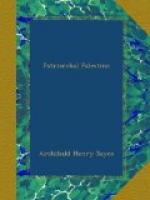It is in the ruined temple of Medinet Habu that Ramses III. has recorded his victories and inscribed the names of the peoples and cities he had overcome. We gather from the latter that his armies had followed the roads already traversed by Ramses II., had marched through the south of Palestine into Moab, and had made their way along the sea-coast into Northern Syria. One after the other we read the names of Hir-nam or Har-nam, called Har-Nammata in the Mohar’s Travels, of Lebanoth, of Beth-Anath and Qarbutu (Josh. xv. 59), of Carmim, “the vineyards,” and Shabuduna or Shebtin, of Mashabir (?), of Hebron and its ’En or “Spring,” of the “district of Libnah,” of ’Aphekah and ’Abakhi (Josh. xv. 53), of Migdal—doubtless the Migdal-Gad of Josh. xv. 53—and Qarzak, of Carmel of Judah and the Upper District of Debir, of Shimshon and Erez Hadasth, of the district of Salem or Jerusalem and the “Lake of Rethpana,” of the Jordan, of Khilz the fortress, of Korkha and of Uru. A second list gives us the line of march along the shores of the Mediterranean Sea. First we have ’Akata, perhaps Joktheel in Judah (Josh. xv. 38), then Karka and [Zidi]puth, Abel and the district of Sela’, the district of Zasr and Jacob-el, Rehuza, Saaba and Gaza, Rosh-Kadesh, Inzath and the “Spring,” Lui-el, which we might also read Levi-el, Bur, “the Cistern,” Kamdu, “Qubur the great,” Iha, Tur, and finally Sannur, the Saniru of the Assyrian texts, the Shenir of the Old Testament (Deut. iii. 9). This brings us to Mount Hermon and the land of the Amorites, so that it is not surprising to find after two more names that of Hamath.
One point about this list is very noticeable. None of the great Phoenician cities of the coast are mentioned in it. Acre, Ekdippa, Tyre, Sidon, and Beyrout are all conspicuous by their absence. Even Joppa is unnamed. After Gaza we have only descriptive epithets like “the Spring” and “the Cistern,” or the names of otherwise unknown villages. With Kamdu in Coele-Syria the catalogue of cities begins afresh.
It is plain that the northern campaign of the Pharaoh was little better than a raid. No attempt was made to capture the cities of the coast, and re-establish in them the Egyptian power. The Egyptian army passed them by without any effort to reduce them. Possibly the Philistines had already settled on the coast, and had shown themselves too strong to be meddled with; possibly the Egyptian fleet was acting in concert with the troops on land, and Ramses cared only to lead his forces to some spot on the north Syrian coast, from whence, if necessary, the ships could convey them home. Whatever may have been the reason, the fact remains that Gaza alone of the cities of the Canaanitish coast fell into the hands of the Pharaoh. It was only in the extreme south, in what was so soon afterwards to become the territory of Judah, that he overran the country and occupied the large towns.




